Shuttle-Mir Team Members (E - G)
Go
to
Team
Members
Group (A -B)
Go
to
Team
Members
Group (C - D)
Go
to
Team
Members
Group (H - K)
Go
to
Team
Members
Group (L - N)
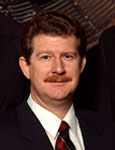 Philip
L. "Phil" Engelauf Profile
Philip
L. "Phil" Engelauf Profile
NASA's Phil Engelauf was the co-chair for the Flight Operations and Systems Integration Working Group. This group developed flight programs and crew work schedules for Phase 1.
The group also devised the requirements for control, communications, and systems integration. The Shuttle-Mir Program allowed NASA to experience some of the differences in long-duration missions as compared to the shuttle missions. In his Oral History, Engelauf said:
"[W]ith short Shuttle missions, we'll work the full nine days or ten days of the flight, with hardly any time off for the crews; they [crew] work long days. I think we have gotten into the habit of giving crews a half day off on anything over about a nine-day flight.
"The Mir crew works on much more of a five-day week, with a steady schedule and they have recreation time available to them. So there's a little bit more of a normalcy to those kinds of operations and feeling that you get up in the morning, you have some time to yourself. You have a work day. Then you're off in the evening, and you have your weekends to yourself.
"Obviously, there were hardware failures and there's overhead tasks, just like the equivalent of our mowing our lawns and doing our laundry on the weekends, that still have to be done by the crews, but it's much less a sense of having your day totally structured for you the way we do in the Shuttle, where we've pretty much planned the crew's time down to the minute.
"Again, this is sort of a mental attitude that we had to get used to in planning the day for the Mir crews and something that we'll carry on into the station program," said Engelauf.
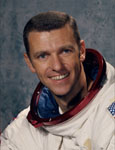 Joseph
H. "Joe" Engle Profile
Joseph
H. "Joe" Engle Profile
Joe Engle was a member of the Stafford - Utkin Task Force. This group was responsible for resolving Shuttle-Mir hardware and operations issues during Phase 1. The task force was led by former U.S. Astronaut Thomas Stafford and Academician Vladimir Utkin from Russia.
"The task force itself was chartered initially by the Gore-Chernomyrdin Committee in 1994," said Engle, during his Oral History.
"The actual requirement or the actual impetus came when our role in the Mir mission was expanded from a one-time visit to a series of 7 to 10 missions. It turned out to be 7 missions, but initially the flexibility was given it to be for from 7 to 10 missions. When, I think, the senior management and also even the administrative officials realized that there was going to be that extensive and that deep of an involvement in the operation and participation of crew members from both sides of the ocean on each other's spacecraft, there was a realization that a better understanding of each other's hardware and operation and how we operate was really needed for safety purposes.
"Up until that time, the agreement was that we would worry about all the procedures and the safety and the training up to our side of the docking interface and the Russians would be responsible for everything on their side of the docking interface. That was okay for one mission, but when 7 to 10 missions became the mode of operation, then I think the realization for better understanding was needed, and the Gore-Chernomyrdin Commission, when they met, when Vice President [Albert] Gore [Jr.] and Prime Minister Chernomyrdin met, they felt that there needed to be a mode of communications perhaps outside of the normal program office line of communications and outside even the administration's line of communication for issues or problems or events that would come up that could benefit from a totally independent top-level type of communications capability with each other. That vehicle should be made up of people who were knowledgeable and competent in operations and hardware of space flight and could understand each other's problems and help arrive at solutions, perhaps from a different perspective than what the program office might be looking from.
"So, the Stafford Task Force was given this responsibility, and of course General Stafford was a natural for it, because he had been extremely respected in Russia's space program, primarily because of the fact that he was the commander of the Apollo-Soyuz mission and had had a number of very good friends, very close friends, in the space business over there, and they respected him and trusted him. So General Stafford was a natural person to lead this group. His responsibilities here with the other businesses that he's associated with and his other obligations here limited the amount of time that he could devote to this and the flexibility of being able to devote, so he asked me to be essentially his deputy or his assistant and to participate in that role or in the capacity," said Engle.
Engle began his career with NASA in 1966, when he was selected as an astronaut. He was the backup lunar module pilot for Apollo 14, and he commanded one of the two crews that flew the approach and landing test flights of the Space Shuttle Enterprise. Engle also commanded STS-2 and STS-51I.
Prior to his NASA career, he served in the United States Air Force and was a test pilot in the X-15 research program. He earned a Bachelor of Science degree in aeronautical engineering from the University of Kansas.
 Christopher
F. Flynn Profile
Christopher
F. Flynn Profile
Christopher Flynn was NASA's flight surgeon for the Wolf Increment. As a flight surgeon, Flynn was responsible for providing pre-flight, in-flight, and post-flight medical support to U.S. Astronaut David Wolf.
Flynn began his pre-flight responsibilities with astronaut Wendy Lawrence, who was initially assigned to this increment. Flynn became Wolf's flight surgeon after Lawrence was deemed too short to fit into the Russian Orlan EVA suit and Wolf was named as her replacement.
Flynn was responsible for the overall health condition of the American-Mir astronaut during training until launch, spending many hours a day with Wolf as he prepared for his long-duration flight. He also taught Wolf medical techniques necessary and potentially necessary on-orbit.
Flynn was also an advocate for issues related to the medical research that involved the American resident aboard the Russian Space Station Mir. In his Oral History, Flynn related that at times it was difficult to perform his duties during Wolf's training in Russia:
"[A]nother thing that happened after Dave Wolf was selected for the NASA 6 mission was a zero-gravity flight, where it's very clearly spelled out that a NASA flight surgeon is part of that flight. And yet when I arrived at the tarmac to get on the plane, I was told that there was not enough parachutes for me to have one. There was enough parachutes for everyone else, including six or seven civilians who were paying to fly on the flight, but there wasn't one for me.
"So that was another crisis where as a flight surgeon you're trying to implement some safety for the crew member, fulfilling your role to NASA (which is you'll to be there if the astronaut needs help).
"Because the whole reason that you're there is to protect a national asset and to make sure that person doesn't get injured after all those years of training, all that hard work. Yet at the same time, the dilemma that I was in -- standing under the wing of that plane was either the crewmember would fly without me or they wouldn't fly without me.
"If they didn't fly on that training flight, then they might not pass their training requirements and therefore the Russians would not allow them to fly to Mir. So the crewmember had an impossible situation of saying, 'Well, you know, Chris, I really want you to fly on the flight, but when it comes right down to it, I can't give up this flight if they won't let you get on.' At the same time, as the flight surgeon, I'm standing there saying, 'Well, the minute we stop having flight surgeons participate in dangerous things once, then that's the new set point for dealing with the Russian bureaucracy.' "
Read Bob Castle's Oral History
 Richard
K. Fullerton Profile
Richard
K. Fullerton Profile
Richard Fullerton from NASA served as co-chair for the Extravehicular Activity (EVA) Working Group for the Phase 1 Program. This group was responsible for defining both the EVA requirements and the hardware necessary to support spacewalks made during Phase 1.
Fullerton worked closely with his Russian counterparts to ensure requirements were met for the many EVAs scheduled as part of the Shuttle-Mir Program. From this association, he was able to learn many lessons that assured success:
"The Russians are very practical oriented. They want to know why and they want a real solid reason why you want to do something. If you change, they want to understand. They have personalities just like we do, and they have schedule problems, financial problems, some more or less than we do. A lot of the non-technical things are really what drive what our difficulties are at the moment. But they all know the fundamentals and they've been around à"
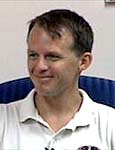 Scott
D. Gahring Profile
Scott
D. Gahring Profile
Scott Gahring was NASA's Operations Lead for the Thomas Increment. His tasks included coordinating communications between Mir astronaut Andrew Thomas, NASA, and Russia from the TsUP (Russia's Mission Control Center).
As lead of the Increment 7 Mir Operations Support Team, Gahring managed a group that included a mission science representative, a biomedical engineer, a payloads systems engineer, an operations support tech, a flight surgeon, and a public affairs representative. As an Ops Lead, Gahring also accompanied Thomas during his training in the U.S. and in Star City, Russia. The many hours spent together enabled the two Mir 7 team members to have a good rapport and provided both a solid knowledge of the experiments that Thomas would be performing on-orbit.
Prior to his Ops Lead duties, Gahring was technical assistant to Phase 1 Program Manager Frank Culbertson. Additionally, Gahring worked in the Space Station Program Office and served in the United States Air Force. In his Oral History, Gahring commented on his job in Russia:
"Probably like three-quarters of the way through, after we'd gotten past our major problems, and the light was out there at the end of the tunnel, and you start thinking about what you're going to have to go back to, and you start thinking, 'You know, this is a pretty good job.'
"You've got a small team of people who pretty much know what they're doing, . . . and we're getting to go to this foreign country. You've got a small team, you're in charge. It's a relatively noble goal, and you're getting to report at a high level . . .
"[A] lot of people didn't really think Phase 1 was that much, but it was a good program. It was a good thing to have done. I don't care what anybody says. It was a nice way to serve, a nice thing to do."
Read Scott Gahring's Oral History
Read more about Operations Leads and Russian Interface Officers
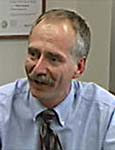 William
H. Gerstenmaier Profile
William
H. Gerstenmaier Profile
Bill Gerstenmaier was NASA's Operations Lead for the Lucid Increment. He coordinated communications between U.S. Mir astronaut Shannon Lucid, NASA, and Russia from the Russian Mission Control Center.
In this position, he was in charge of the Mir Operations Support Team for Increment 2. Duties included managing a group with a mission science representative, a biomedical engineer, a payloads systems engineer, an operations support tech, a flight surgeon, and a public affairs representative.
In his Oral History, Gerstenmaier commented on the high level of cooperation he and Lucid received during her flight, including those supporting the science experiments:
"I think the other thing that was amazing is we would schedule certain experiments in a certain time, and then the principal investigators would be back in the United States, so it would be like 2 a.m. or 3 a.m. in the morning. They would be listening to the air-to-ground conversations between Shannon and myself, and then when something wouldn't work, if there was something that they could make a comment on right away, they would call down on the phone.
"I'd pick up the phone and understand what they told me and then tell Shannon. So we were able to give her pretty good support. So she really had a pretty extensive team behind her."
Also in support of Phase 1 activities, Gerstenmaier made several trips from the Johnson Space Center in Houston, Texas, to Russia. During one trip, he negotiated protocols with the Russians over such areas as downlink time for public affairs events, medical requirements, science requirements, and the ratio of Russian to American food for the Mir residents.
Prior to his Phase 1 duties, Gerstenmaier served as a NASA flight controller, a career that began with the first flight of the space shuttle in April 1981 and continued through STS-51B four years later. Gerstenmaier has an extensive background in propulsive systems, and he has flown shuttle payloads as a customer. He has said that he wanted to work on Phase 1 to prepare himself for future operations on the International Space Station.
Read
William Gerstenmaier's Oral History
Read
more about Operations Leads and Russian Interface Officers
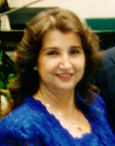 Jessie
M. Gilmore Profile
Jessie
M. Gilmore Profile
Jessie Gilmore was the executive secretary/assistant to Program Manager Frank Culbertson in NASA's Phase 1 Program Office. Prior to her Phase 1 duties, Gilmore was a secretary in the astronaut office. In her Oral History, Gilmore described one of her many duties:
"[Y]ou set up all your Team Zero [meetings], which was a joint working group meeting between the Russians and the Americans. I handled all the meeting places, [coordinating] their meeting schedule, saw to it they got to the places they were supposed to get on time. I set up any of the receptions that were needed down there [Kennedy Space Center]; took care of them for their tours; their viewing of the launch; saw to it they got from the airport to the airport [by making arrangements with TechTrans Inc. (TTI)]; took care of the Americans that were down there supporting those meetings; making sure that the faxes were sent; the meetings were set up. Some of the [meetings were held at] two or three o'clock in the morning, since they were eight to nine hours ahead of us in Russia. Sometimes it required multiple meetings."
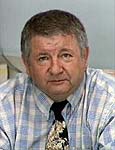 Yuri
N. Glaskov Profile
Yuri
N. Glaskov Profile
Yuri Glaskov of the Gagarin Cosmonaut Training Center was the co-chairman of crew training for the Phase 1 Management Working Group. He has been with the Russian space program since 1965 when he joined the cosmonaut corps. As a cosmonaut, Glaskov spent 18 days on the orbital station Salyut-5 in 1975.
Glaskov spoke of the types of training in his Oral History. He shared information on the "special program of psychological training" needed to endure long-duration missions.
"We conduct a special monitoring research when we put our crew members into complete isolation for a certain period of time, into an isolation chamber. I had to myself be in this chamber for fourteen days. It is called that you're 'alone in public.' Everybody is watching you, but you can't see anybody. There are certain psychological nuances there, because you fight yourself.
"Also I had to experience, for thirty-five days, a test of the orbital station on the ground. At that time there was two of us, but the hatches were closed and we were absolutely alone for thirty-five days. This experience created different problems. Here we had to tolerate each other, forgive each other, and supplement each other's faults or experiences. This creates its own problems. One person doesn't like certain traits of another, and so you have to learn to adapt to each other.
"When the crew is three people or more, that becomes even more difficult. Every person has his own personality. We even noticed that a certain thing happens when two people unite against the third one. But this changes. This combination changes.... In that, we have to bear in mind, were people of the same country, from the same cultural background, from, let's say, former Soviet Union. If you were a Russian or a Ukrainian, you basically had the same background. But here [with Phase 1] you have an international element coming into play, and that makes things even more difficult."
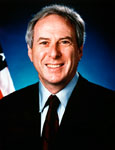 Daniel
S. Goldin Profile
Daniel
S. Goldin Profile
As NASA Administrator, Daniel S. Goldin had final authority and responsibility for the Phase 1 Shuttle-Mir Program. He was also instrumental in initiating, developing and sustaining Phase 1, as part of the International Space Station Program.
Goldin became NASA's Administrator in the spring of 1992. Within a few months, he was traveling to Russia with an American interagency-delegation to discuss terms of the agreements that established Phase 1. Goldin met with the Russian Space Agency (RSA) Director General Yuri Koptev and the two ratified the United States-Russian Space Cooperation Agreement.
On October 5, 1992, Goldin and Koptev met in Moscow to sign the "Implementing Agreement between NASA and RSA on Human Space Flight Cooperation." This document detailed cooperation that included a Russian cosmonaut flying as a mission specialist on shuttle mission STS-60; a U.S. astronaut launching in a Soyuz to spend more than 90 days on the Mir, then returning in a shuttle; Russian cosmonauts on Mir being "changed out" via the shuttle on the same flight that would return the U.S. astronaut; and evaluation of the Russian Androgynous Peripheral Docking Assembly.
The Phase 1 Program was altered in September 1993, when an agreement between Russia and the United States culminated with additional astronauts residing on the Mir, as well as plans for Russia to participate in the International Space Station. During the duration of the Phase 1 Program, Goldin's responsibility for Phase 1 included deciding to send astronaut David Wolf to Mir, after a dangerous fire had occurred onboard Mir during Jerry Linenger's stay. Goldin commented on this decision in a September 25, 1997, statement, excerpted here:
"I will not trivialize the risks involved in human space exploration. Like all Americans, I know every time an astronaut travels to space there is risk. When we build the International Space Station we will encounter similar problems and there will be danger.
"But NASA is ready.
"We are ready because the reviews assure us. But we're also ready because it's the right thing to do. Americans press forward.
"We overcome the unexpected. We discover the unknown. That has been our history. That's America's destiny.
"I love this country very much, and I feel privileged to serve with so many dedicated, talented and courageous individuals. Today, more than ever, I am proud of everyone at NASA for their commitment to America's future and for their service to humankind. And to David Wolf , Michael Foale and the rest of the Shuttle Atlantis crew . . . Godspeed. We'll see you when you get home."
Before coming to NASA, Goldin was Vice President and General Manager of the TRW Space and Technology Group in Redondo Beach, CA. During a 25-year career at TRW, Goldin led projects for America's defense and conceptualized and managed production of advanced communication spacecraft, space technologies and scientific instruments. He began his career at NASA's Lewis Research Center, Cleveland, OH, in 1962, and worked on electric propulsion systems for human interplanetary travel.
Valeri V. Grigoriev Profile
Valeri Grigoriev served as the co-chairman of Institutional Communications Working Group. He was the Department Manager, Manned Flight Programs Directorate, Russian Space Agency.
Working Groups consisted of experts from RSC Energia, NASA, RSA, Institute for Biomedical Problems (IBMP), Gagarin Cosmonaut Training Center (GCTC), and other organizations and companies. A list of the Working Groups, their areas of responsibility, and the names of their co-chairs can be found at the Working Group Structure.
Go
to Team Members group (A - B)
Go
to Team Members group (C - D)
Go
to Team Members group (H - K)
Go
to Team Members group (L - N)